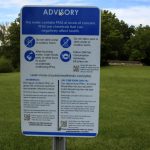It’s time to plan(t)
By Peg McCormick Fleury
As the year winds down, so do your gardening tasks — but there is still time to do a few things in early November, including some late planting and fall cleanup.
October is considered the month to plant bulbs, but you can continue planting until the ground freezes solidly. No time to finish planting individual bulbs? Hold them over and transplant in spring. Dig a trench, place them a few inches apart, cover and mulch. Another option is to force the bulbs, providing an early touch of spring. Check the UW-Extension article, Forcing Bulbs, at <www.uwex.edu/ces/wihort/GardenFacts.html>
Mulching your bulbs will protect them from thaws and freezes and early sprouting. If squirrels are a problem, place a piece of screen or chicken wire over the ground before mulching, or try such repellents as cayenne pepper or mothballs. Animals find some bulbs less attractive so try autumn crocus, daffodils, grape hyacinth (muscari) snowdrops, winter aconite and hyacinth.
Consider new varieties or new planting areas. Squills, grape hyacinths or crocus can be planted at random in flowerbeds or even the lawn. Postpone spring mowing until the bulbs have flowered and set your mower high. This allows leaves to provide energy to the bulbs for next year.
Perennials
This is not prime time to plant perennials, but you may have some great end-of-the-season bargains. To rescue these potted plants, find sheltered spots protected from harsh winter sun and winds and sink pots into the ground. Mulch with evergreen boughs, straw, or something similar.
Opinions differ on when/if to cut back perennials. You can let healthy plants stand for aesthetic value or as a source of food for wildlife. This also helps to locate them next spring. If you cut them back, mark the location so you don’t accidentally injure them when digging (especially important for late-emerging plants).
Plants with disease or insect problems should be pruned back to reduce the chance of carryover. Be sure to remove any diseased leaves from around the plants.
You can save seeds from hardy types such as coneflowers. Store seeds in paper envelopes, and don’t forget to write the name of the plant on the outside! If you have overly aggressive plants, remove and discard the seeds — and not in your compost pile.
This is a good time to take a soil test. Typically this should be done every three to five years. For information, call Milwaukee County Extension at 414-256-4600 or go to <http://uwlab.soils.wisc.edu>
To winterize flower and vegetable beds, remove any last leaves and spread several inches of organic compost matter. Wait until the ground freezes to keep pesky critters from setting up homes under the mulch.
Even if you don’t use your compost pile in winter, you can still recycle vegetable and fruit scraps, eggshells and coffee grounds. A successful tomato gardener says she puts these materials in plastic bags and stores them in a heavy, covered container. The container is kept in a cool or cold garage or even outside — frozen bags will thaw in time for planting. In spring, she digs holes in her vegetable beds and tips a bag of compost in each hole, marking the location with poles. Later the poles support her tomato plants.
Roses are a world unto themselves, with different winterizing techniques for shrubs, climbers, etc. Timing is important; wait until after a week of freezing temperatures to complete winter protection because covering and mulching too early can cause heat buildup, diseases and possible loss of plants. Check the UWEX InfoSource for Roses: protection for winter at <http://infosource.uwex.edu>
Shrubs
You can plant or transplant shrubs as long as the ground is workable. If you have unplanted end-of-season bargains, find a protected location and sink the pots in the ground. You can enclose the plants in a hardware cloth cylinder about 4 feet high to deter pests. Be sure to clear any drifted leaves away from your plantings. Upright arborvitae, yews and junipers can be loosely tied to prvent splitting. This discourages snow buildup that can break the shrub. For additional information, check the UWEX InfoSource web site for Trees & Shrub: special care winter protection.
I also recommend Month by Month Gardening in Wisconsin by gardening expert Melinda Myers. It has many suggestions for winterizing your shrubs, trees and plants. By December, the ground is probably well frozen and we may have had a snowfall. Check fencing and other animal barriers, especially around young trees and shrubs.
Lawns
Grass can be mowed as long as it continues growing. Leave clippings on the lawn or put in the compost pile. Rake up leaves one last time and compost them. This is not the best time for new grass but you can sprinkle seeds on bare or thin spots; future snow is great mulch. For more information check the Lawn Care Calendar at <www.UWEX.edu/ces/wihort/GardenFacts.html>
Tools and supplies
Don’t forget to winterize tools, too. Time spent now will give you a head start in spring. Remove caked soil and rust; sharpen edges of hoes, shovels and trowels, check handles for secure attachment, splinters and rough spots. Make a wish list of new tools (and gardening books!) for possible holiday gifts.
Check gardening supplies and move any that shouldn’t be exposed to freezing temperatures. Clean, sort and take inventory of pots and containers. Empty pots, otherwise soil can freeze and crack them.
Holiday hints
Holiday decorations can definitely be recycled. Evergreen branches from discarded wreaths, trees, etc. make excellent winter protection. Don’t worry about placing them on top of the snow.
One gardener suggests stripping boughs from discarded wreaths. In spring, she places the metal wreath frames over multi-stemmed plants. As plants grow, she raises the frame by adding metal legs or supports. Check UWEX InfoSource for information on caring for holiday plants such as poinsettias or Christmas cactus. There is also helpful information on that site about selecting, caring for and recycling Christmas trees.
Happy New Year
As temperatures fall and snow swirls, pull out your gardening journal or photos to recall last season’s successes and problems. Immerse yourself in garden books, publications and nursery catalogs and let ideas percolate. Soon there will be information on gardening lectures, workshops and classes. Consider enrolling in a UW-Extension Master Gardening general training class (classes usually start in January). This will provide you with valuable information that you can use in your yard, and share as a community volunteer.
Enjoy the downtime of winter, but also think spring!





















